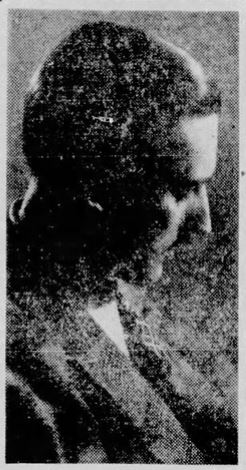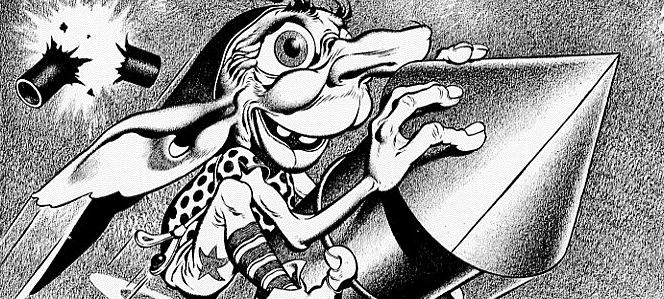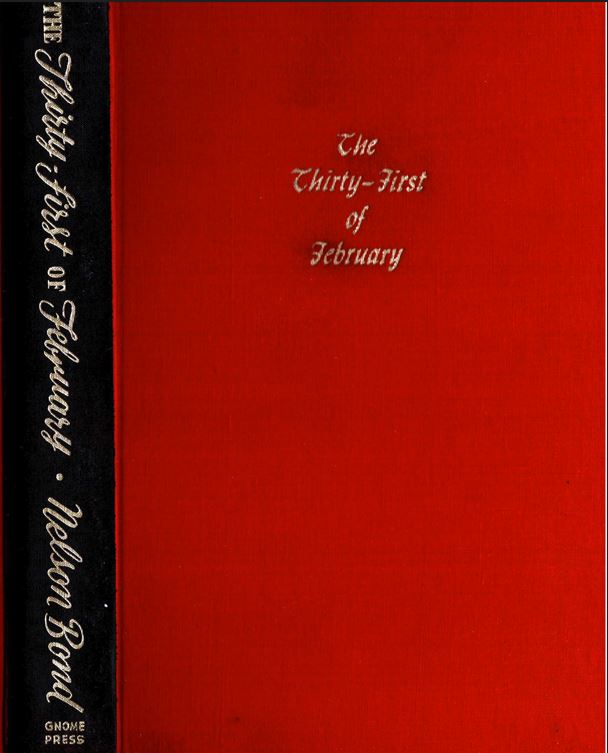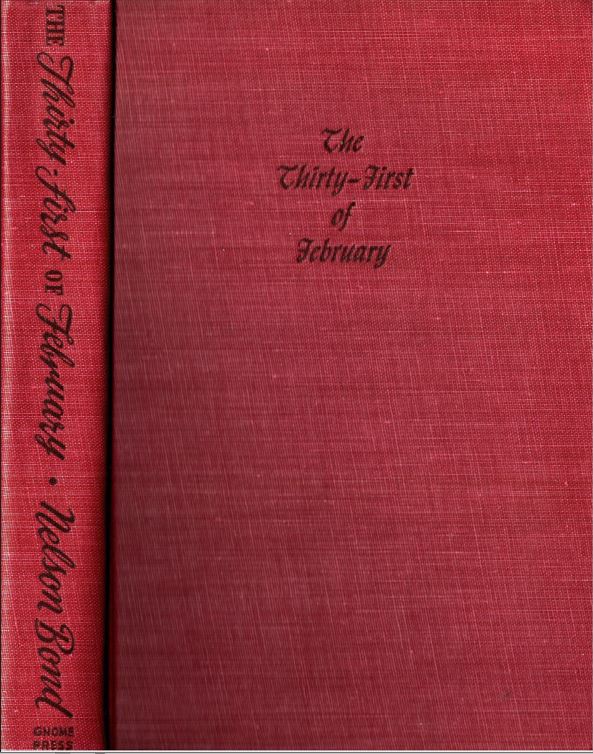 Nelson Slade Bond (1906-2006) is an almost forgotten figure today, but in the 1940s he was a huge name, prominent not just in the field but in the mainstream world to an almost unprecedented degree. His writing career started when he attended Marshall College at the fairly late age of twenty-four, but he quickly became editor of the student newspaper and a stringer for the city paper. A vignette in the pulp Top-Notch Magazine was his first fiction sale in 1935. He sold ten stories to Astounding and had a string of stories about spaceman Lancelot Biggs but his fame arose from his fantasies.
Nelson Slade Bond (1906-2006) is an almost forgotten figure today, but in the 1940s he was a huge name, prominent not just in the field but in the mainstream world to an almost unprecedented degree. His writing career started when he attended Marshall College at the fairly late age of twenty-four, but he quickly became editor of the student newspaper and a stringer for the city paper. A vignette in the pulp Top-Notch Magazine was his first fiction sale in 1935. He sold ten stories to Astounding and had a string of stories about spaceman Lancelot Biggs but his fame arose from his fantasies.
One of those was his first major story, a whimsical piece called “Mr. Mergenthwirker’s Lobblies,” published in the prestigious Scribner’s Magazine in 1937. A radio show was soon adapted from it and Bond, realizing that another writer was getting paid for his ideas, turned to radio himself, writing hundreds of episodes. After the war he was a prime catch for the nascent television world. A version of the story ran on NBC in 1946. “It was,” according to a Bond interview, “the first full-length television play ever performed, live, on network TV, which then consisted of Washington, New York and Boston.” Somebody must have seen it and taken notice, because the BBC ran its own production in 1949. Samuel French published the play in book form in 1951. And more importantly for Marty Greenberg, the mainstream publisher Coward-McCann published a collection, Mr. Mergenthwirker’s Lobblies and Other Fantastic Tales, in 1946, making Bond one of the first genre writers to appear in the mainstream press.
He continued writing for magazines and television until the late 1950s when he opened a public relations office. That gave him ulcers and he became an antiquarian bookseller in 1965 until his retirement a quarter-century later.
Forrest J. Ackerman wrote in a review that “Bond is a conscientious craftsman who polishes up his pulp work before permitting it to be bound between hard covers, and the result is quite commendable.” If so, all the stories listed should be marked as revised, but I have not been able to find all the originals.
 — cover art by Harold W. McCauley
— cover art by Harold W. McCauley
Gnome Notes
Clearly, Bond was a catch. All the small presses pursued him, and Prime Press won out by a nose. Slightly better established than Gnome – they had been around since 1947 and had twice as many books to their name – Prime could also offer a draw to an author’s ego. They had started publishing special high-quality, signed, numbered, slipcased editions of their books the previous year. Bond gave them Exiles of Time, published as a complete novel in 1940 in Blue Book, a pulp but the highest end of the pulps, up with Argosy. Prime did a run of 1000 copies, standard for them, plus another 112 copies of the slipcased edition.
That couldn’t have hurt Greenberg at all. His collection of 13 Bond stories would be coming out close on the heels of Exile. Even better, for the first and last time in Gnome history, he had a blurb to plaster across the back cover. And what a blurb. James Branch Cabell, the author of Jurgen, A Comedy of Justice, a scandalous 1926 best seller and one of the major mainstream American fantasy works of the pre-war era, pronounced that Bond had “genius.” You give an author like that anything he wants. And if what he wants is a special high-quality, signed, numbered, slipcased edition of his work that he would buy all the copies of so he could sell in his store, you run to the printer to comply.
The details of the printing and the editions are not fully agreed upon, and none of the normal sources appears to be entirely accurate. What follows is my best guess on unraveling the mess, but I can’t confirm all of it.
Greenberg raised the number of copies printed to 5000, a sign that Dave Kyle had stopped using the inadequate facilities at Advisor Press, although the actual printer is unknown. CHALKER says that only half were bound, but that seems unlikely since no trace of a second state binding has ever appeared. The title disappears off back panels as early as 1951; surely if they had sold 2500 copies in two years a second binding would have been mandatory as with The Carnelian Cube. CURREY describes the book as “magenta boards lettered in black” but changes “boards” to “cloth” in his 2002 Revision, quite rightly. My wife, who has a better eye for color than I do, balked at “magenta,” declaring there wasn’t enough blue in the shade. Other dealers list the book as “red,” “reddish-purple,” and “rose,” a term I hadn’t seen since my stamp collecting youth. Black lettering would normally be indisputable. Looked at in bright daylight, the ink is certainly black, but a much lighter shade of black than used on any other Gnome title. At first glance indoors you’d probably guess a deep red of some kind and indeed several online listings call it a “darker red.” I’ll go with “magenta cloth lettered in black” on the principle of not deviating from the standard CURREY descriptions unless absolutely necessary, but be aware that the colors are, as with so many Gnome titles, previously unknown to human eyes.
The special slipcased edition has its own questions attached. Everybody agrees that 112 copies were in this format, of which 100 were for sale while the other 12 were reserved for Bond’s personal use. Whether extra copies were printed is an open question. The paper and interior appear identical, and it seems likely that Greenberg would have just slipped them out of the pile of 5000 copies to be bound. He did change the material for the binding. It is a beautiful cloth CURREY calls crimson, with gold lettering on the cover and on the spine that CHALKER says was dyed black. The slipcase is cheap black cardboard. The “special” packaging couldn’t have cost Greenberg more than a pittance, but the cover price was raised from $3.00 to $5.00. Even with the discount Bond must have received, that would have been a tidy profit for Gnome. CURREY makes an error here as well. “Enclosed in paper slipcase, issued without dust jacket,” he wrote. In his Revision he corrects that to be more precise:
12 copies reserved for use of the author were enclosed in paper slipcase and apparently issued without dust jacket. 100 copies for sale were issued in dust jacket and apparently some if not most were issued without the paper slipcase.
The page in the hardcover that had previously displayed only the title now had text appended:
This special autographed edition of
THE THIRTY-FIRST OF FEBRUARY
is limited to 112 copies of which
one hundred are for sale.
This is Number . . . . .
My personal copy, Number 59, has an additional inscription, in precise calligraphy:
Especially inscribed for/the Fantasy Foundation/with the author’s earnest/admiration for its/fine efforts ~
 I didn’t realize what I had until I researched The Fantasy Foundation. That was the name that legendary sci-fi fan Forrest J Ackerman – Forry, 4E, 4SJ, Forrest J with no period after the J – gave to his equally legendary collection of sci-fi books. I normally would never use the term sci-fi, but Forry was the one who coined it. By 1942 he had already amassed 1300 titles within the broadest definition of f&sf, the world’s largest collection. Drafted in 1942 and fearful that he might not survive the war, he drew up a will that bequeathed his collection and $1000 to the Fantasy Foundation, something that didn’t exist but which he hoped would be established as a research body to create a sorely needed Master List of Imaginative Literature. No bibliographies or encyclopedias or research apparatus of any kind existed in 1942 to enable the few interested scholars to study the field. Those would appear after the war; indeed some of the small presses were established to print these compilations.
I didn’t realize what I had until I researched The Fantasy Foundation. That was the name that legendary sci-fi fan Forrest J Ackerman – Forry, 4E, 4SJ, Forrest J with no period after the J – gave to his equally legendary collection of sci-fi books. I normally would never use the term sci-fi, but Forry was the one who coined it. By 1942 he had already amassed 1300 titles within the broadest definition of f&sf, the world’s largest collection. Drafted in 1942 and fearful that he might not survive the war, he drew up a will that bequeathed his collection and $1000 to the Fantasy Foundation, something that didn’t exist but which he hoped would be established as a research body to create a sorely needed Master List of Imaginative Literature. No bibliographies or encyclopedias or research apparatus of any kind existed in 1942 to enable the few interested scholars to study the field. Those would appear after the war; indeed some of the small presses were established to print these compilations.
Forry outlived the war and his collection never left his hands, growing to at least 50,000 books and more than 200,000 other items. The collection took on the informal name of the Fantasy Foundation. Clearly Bond intended this copy to be part of it. Forry finally started selling his collection in 2002, after years of failing to find a proper home for it. That completes the circle, except for one thing: I bought this book in 1997. How it escaped Forry’s clutches and made it to mine is another Gnome mystery.
I haven’t seen one of Bond’s 12 reserved copies, so I don’t know if the internal note about the numbering is present in those. I have to assume so because a listing for #9 was placed. This was Greenberg’s file copy, inscribed: “For Marty Greenberg: This very extra-special copy of my book, of which he may with justice claim to be foster parent-Nelson Bond.”
I had the great fortune to have Bond sign the other two variants. In 1995, The Science Fiction and Fantasy Writers of America (SFWA) had a good idea. It created an honor “as a way to recognize and appreciate senior writers in the genres of science fiction and fantasy who have made significant contributions to our field but who are no longer active or whose excellent work may no longer be as widely known as it once was,” awarding them the title of Author Emeritus. Bond, who had mostly stopped writing in the 1950s, eminently qualified and became the fourth Author Emeritus, following fellow Gnome name Judith Merril. At the age of 93 he made the trek to Santa Fe, site of that year’s annual Nebula Awards dinner and presentation.
After nearly half a century with the most minimal contact with others in the field, he had no idea what the reception would be and he was visibly moved by the outpouring of respectful attention and admiration showered upon him by the writers gathered there. That happened to be one of the few Nebula ceremonies I ever attended, but I came prepared with my copies of The Thirty-first of February. At a reception for him, we chatted while Bond put a nice inscription on the hardcover and stared at the trade paperback, then immediately launched into that staple of all old Gnome Press writers – the Marty Greenberg was a crook story.
Was Greenberg a crook? That’s a word game. We know he was perpetually short of funds almost from the day that Gnome opened until the day it closed, owing the printer more than $100,000. Greenberg pulled every dodge he could think of, and tried to get away with every scheme that would delay making his negative balance any more negative. The games he played with the printer need to be related elsewhere. With most authors he simply delayed or pleaded lack of sales. He paid promptly on threat of lawsuit, as the old saying goes.
Now for a seeming digression. From 1943 to 1946 the Council on Books in Wartime printed an astounding 123,000,000 copies of 1227 titles to distribute free reading material to U.S. troops. These Armed Services Editions were cheaply printed but highly valued. They were, in fact, often read to death. In order to make them available to many readers simultaneously, the first reader would tear off a chapter and hand it to a second reader, who would pass it along to a third upon receiving the second chapter and so on. Whole copies didn’t have much longer lives. Most soldiers didn’t consider the books worth hauling back to America from halfway around the world. Today the rarity of these books builds against their fragility to make them collectible, with a full set beyond dreams. It’s possible that the Library of Congress has the only complete set, although a few university collections are close. The completist mania of science fiction fans makes the tiny number of titles that have a connection to the field – The Time Machine, Dracula, Tarzan – among the most expensive. No contemporary f&sf authors were ever published, not surprising since virtually no titles existed to be reprinted.
Only a few years later the U.S. was back at war, in Korea. Hundreds of thousands of soldiers once again needed books. Greenberg saw a market. Already printed pages from Pattern for Conquest, Cosmic Engineers, I, Robot, and The Thirty-First of February were bound with plain white paper that had the front covers of the books reproduced on them, with bare print on the spine and a blank rear. (Paper-covered editions are technically known as wrappers. You can refer to any mass-market or trade paperback as being in wrappers, but their covers are usually of stiffer or thicker paper than the thin paper on the Gnome editions. Dust wrapper as a synonym for dust jacket is sometimes seen and so is the term wrappers but neither shouldn’t be confused with softbound editions. Yes, book collecting is often a mess even outside of Gnome.) The WWII Armed Services Editions cost six cents to print; since the Gnomes needed only covers they must have cost even less. With a nominal cover price of $1.00 they could be sold to the government for some wholesale fraction of that and it would be almost pure profit. There wouldn’t even be the small cost of paying the writers royalties on the titles. You see, Greenberg never bothered to tell them what he had done.
You can excuse a lot of the practices of Gnome and the other small presses as sheer survival techniques. This goes beyond redemption. And Greenberg must have known this because just about everything concerning what are now called the Armed Forces paperbacks is a complete mystery. We don’t know for sure why these titles were picked and not others. We don’t know when they were bound and whether the copies came from pages lying in a warehouse or newly printed. We don’t know how many copies were bound. We don’t know what they sold for. Kemp write that he “has seen copies with a .50¢ and .60¢ price on the front cover, knocked out in a small white square on the front cover.” No such images appear on the internet, though. CHALKER does mention the $1.00 price at one point but I’m not sure where he got that or if that applied to all four. We know for certain that they weren’t advertised at a dollar. An advertised book might be seen by the author, and that was the last thing Greenberg wanted. We don’t know how they were distributed, to whom they were sold, whether they ever went to Korea or were read by soldiers. I can’t find any information about a program equivalent to the Armed Services Editions for the Korean War. The only piece of evidence that the books went to Korea is purely negative: more of them have disappeared than would be the case if U.S. buyers could grab hold of them. This verges on the surreal. Greenberg tried to run a publishing business by deliberately keeping some of his books a total secret. We’re way past science fiction into the X-Files.
Somehow Nelson Bond learned of the scheme. He confronted Greenberg and forced a royalty payment from him.
At this point you should be asking yourself the question that didn’t occur to me at the time. If all the copies went to the Armed Forces, how was there a set of copies for Bond to take with him? I don’t know. How many did he take? I don’t know. In 1998 he seemed surprised just to see one in my hands, so it couldn’t have been many.
Morgan A. Wallace compiled a summary of information for Paperback Parade in 1995, titled Gnome Press Paperbacks 1950-1951/2. I researched the subject independently before finding his article, and I see we’ve come to the same conclusions and are missing the same set of information. Almost everyone involved is dead today and unless a lost trove of documents surfaces, we’re stuck on this near zero level of knowledge forever.
But we’re also left with the most interesting title of all the 86 in terms of editions, and the slipcased version is surely the prettiest book of them all. It makes you wonder what Greenberg could have done if he had the money of a mainstream publisher. Though you should also imagine what the asking price of a signed, numbered special edition of I, Robot or Sixth Column would be today and be grateful that you don’t have to raise the limit of your credit card to cover that many zeroes.
Contents and original publication:
• “The Sportsman” (Scribner’s, February 1938)
• “The Mask of Medusa” (Blue Book, December 1945)
• “My Nephew Norvell” (Blue Book, July 1946)
• “The Ring” (Blue Book, June 1943, as “The Ring of Iscariot”)
• “The Gripes of Wrath” (Blue Book, August 1946)
• “The Cunning of the Beast” (Blue Book, November 1942, as “Another World Begins”)
• “The Five Lives of Robert Jordan” (Blue Book, April 1945)
• “’Take My Drum to England’” (Unknown, August 1941)
• “Saint Mulligan” (Fantastic Adventures, May 1943)
• “The Monster from Nowhere” (Fantastic Adventures, July 1939)
• “The Enchanted Pencil” (Blue Book, November 1946)
• “Pilgrimage” (Amazing Stories, October 1939, as “The Priestess Who Rebelled”)
Reviews
August Derleth, Madison Capital Times, August 5, 1949
All these tales are eminently worth reading … Among modern authors of fantasy, Nelson Bond is one of the most urbane, one of the most entertaining, one of the easiest and most delightful to read.
Orville Prescott, New York Times, July 6, 1949
Mr. Bond has a way of trampling all over his own stories.
Frederik Pohl, Super Science Stories, November 1950
Bond … has little to say to science-fiction and fantasy readers, for there is very little in the way of fresh ideas or daringly imaginative themes… But what he says is said with impeccably smooth writing…
Bibliographic information
The Thirty-first of February, by Nelson Bond, 1949, copyright registration 18Jun49, Library of Congress Catalog Card Number [retroactively [49-49009], title #3, back cover #3, 272 pages. 5000 hardback copies printed, 1949, 112 slipcased hardback copies, 1949; unknown number of trade paperback copies printed, 1952?. Jacket design by James Gibson. “First Edition” on copyright page. Manufactured in the United States of America. No printer designated. Title page and copyright registration add “With a Conveyance of Title in Fee Simple by James Branch Cabell.” Back panel prints Cabell poem, and adds Cabell blurb along with a photograph of Bond. No other Gnome titles mentioned; The Carnelian Cube and The Porcelain Magician are listed on the rear flap. Gnome Press address given as 421 Claremont Parkway, New York 57, N. Y.
Variants, no known priority for hardbacks, paperback later
1) (CURREY A) Hardback, crimson cloth with gold lettering on front cover and on black spine. Slipcased in black cardboard. Interior of case may have patterned design or be plain. 100 numbered, signed by Bond; 12 author’s copies. Dust jacket is identical to 2) so retains listed price of $3.00, but sold for $5.00.
2) (CURREY B) Hardback, magenta cloth, spine lettered in black. $3.00.
3) Trade paperback, front cover identical to hardback dust jacket; back cover is blank white. Spine reads The Thirty-first of February • Nelson Bond in magenta lettering on white background. Stated “First Edition” but is later issue.
Images





